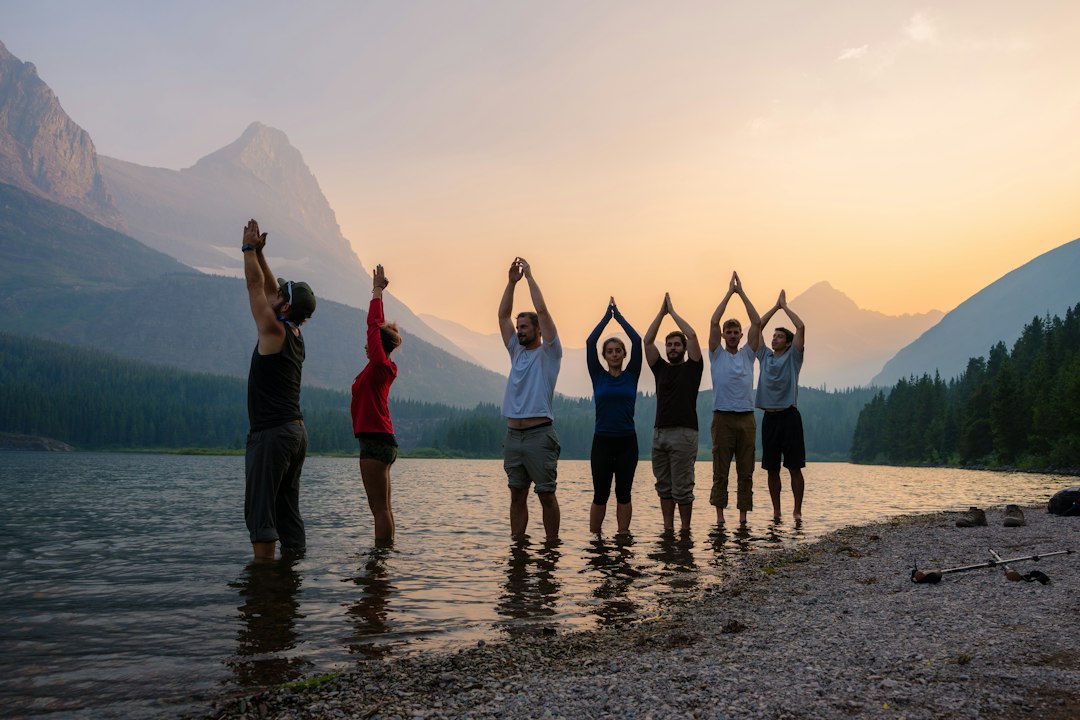Outdoor yoga and mindfulness retreats in nature have become increasingly popular in recent years. These retreats offer a unique opportunity to connect with nature, cultivate mindfulness, and deepen one’s yoga practice. In a world that is becoming increasingly fast-paced and disconnected from the natural world, these retreats provide a much-needed respite and a chance to reconnect with ourselves and the world around us.
The practice of yoga has long been associated with mindfulness and the cultivation of inner peace. By taking our practice outdoors and immersing ourselves in nature, we can enhance these benefits even further. The sights, sounds, and smells of the natural world can help to ground us and bring us into the present moment, allowing us to fully experience the beauty and wonder of the world around us.
The Benefits of Outdoor Yoga and Mindfulness Retreats in Nature
There are numerous benefits to practicing yoga and mindfulness in nature. Firstly, outdoor yoga retreats offer an opportunity to improve physical health and fitness. Practicing yoga outdoors allows for a greater range of movement and flexibility, as well as increased strength and balance. The natural terrain also provides a more challenging environment for practicing yoga poses, which can help to build strength and stability.
In addition to physical benefits, outdoor yoga retreats also offer mental and emotional benefits. Spending time in nature has been shown to reduce stress and anxiety, improve mood, and increase feelings of well-being. The combination of yoga and mindfulness practices in nature can help to calm the mind, reduce racing thoughts, and promote a sense of inner peace.
Furthermore, outdoor yoga retreats can enhance spiritual connection. Being surrounded by the beauty of nature can evoke a sense of awe and wonder, allowing us to tap into something greater than ourselves. This can deepen our spiritual practice and provide a sense of purpose and meaning in our lives.
Connecting with Nature: A Key Element of Outdoor Yoga and Mindfulness Retreats
Connecting with nature is a key element of outdoor yoga and mindfulness retreats. Being present in nature allows us to fully experience the beauty and wonder of the natural world. It helps us to slow down, let go of distractions, and be fully present in the moment.
Grounding and earthing are also important aspects of connecting with nature. Grounding refers to the practice of physically connecting with the earth, such as walking barefoot on the grass or sand. This can help to balance our energy and promote a sense of stability and grounding. Earthing, on the other hand, involves connecting with the earth’s energy by spending time in nature. This can help to reduce inflammation in the body, improve sleep, and promote overall well-being.
Mindful observation of natural surroundings is another important aspect of connecting with nature. By observing the sights, sounds, and smells of the natural world, we can cultivate a sense of awe and wonder. This can help to shift our perspective and bring us into a state of gratitude and appreciation for the world around us.
The Importance of Mindfulness in Outdoor Yoga Practice
Mindfulness is a key component of outdoor yoga practice. Mindfulness involves paying attention to the present moment without judgment. It allows us to fully experience each breath, each movement, and each sensation in our bodies.
In outdoor yoga practice, mindfulness can help us to fully immerse ourselves in the natural environment. By bringing our attention to the sights, sounds, and smells of nature, we can deepen our connection with the world around us. This can help to calm the mind, reduce stress, and promote a sense of inner peace.
There are several techniques for cultivating mindfulness in nature. One technique is to bring awareness to each breath as we move through our yoga practice. By focusing on the breath, we can anchor ourselves in the present moment and cultivate a sense of calm and centeredness.
Another technique is to bring awareness to the sensations in our bodies as we move through each yoga pose. By noticing the physical sensations, we can bring our attention out of our heads and into our bodies. This can help to quiet the mind and promote a sense of embodied presence.
The Role of Breathwork in Outdoor Yoga and Mindfulness Retreats
Breathwork is an essential component of yoga practice, and it plays a particularly important role in outdoor yoga and mindfulness retreats. The breath is a powerful tool for calming the mind, reducing stress, and promoting a sense of relaxation and well-being.
In outdoor yoga practice, breathwork can help us to connect with the natural environment and deepen our sense of presence. By bringing awareness to each inhale and exhale, we can synchronize our breath with the rhythm of nature. This can help to create a sense of harmony and balance within ourselves and with the world around us.
There are several techniques for incorporating breathwork into outdoor yoga practice. One technique is to practice deep belly breathing, also known as diaphragmatic breathing. This involves breathing deeply into the belly, allowing it to expand on the inhale and contract on the exhale. This type of breathing helps to activate the relaxation response in the body and promote a sense of calm and relaxation.
Another technique is to practice alternate nostril breathing, also known as Nadi Shodhana. This involves using the thumb and ring finger to alternate closing off one nostril at a time while inhaling and exhaling through the other nostril. This type of breathing helps to balance the energy in the body and promote a sense of calm and clarity.
Exploring the Connection Between Yoga and Nature

The connection between yoga and nature has deep historical and cultural roots. Yoga originated in ancient India, where it was practiced by sages and yogis who sought to connect with the divine through meditation, breathwork, and physical postures. These early yogis often practiced in natural settings, such as caves, forests, and mountains, as they believed that nature was a powerful source of spiritual energy.
Practicing yoga in nature offers numerous benefits. Firstly, it allows us to connect with the natural world and tap into the energy and wisdom of the earth. This can help to deepen our spiritual practice and provide a sense of grounding and stability.
Secondly, practicing yoga in nature allows us to experience the beauty and wonder of the natural world. The sights, sounds, and smells of nature can evoke a sense of awe and wonder, helping us to shift our perspective and connect with something greater than ourselves.
Lastly, there is a deep connection between yoga philosophy and nature. Yoga philosophy teaches us that we are all interconnected and part of a larger whole. By practicing yoga in nature, we can experience this interconnectedness firsthand and cultivate a sense of unity and oneness with the world around us.
The Power of Silence and Stillness in Outdoor Yoga and Mindfulness Retreats
Silence and stillness are powerful tools for deepening our connection with ourselves and the natural world. In outdoor yoga and mindfulness retreats, silence and stillness can help to quiet the mind, reduce distractions, and promote a sense of inner peace.
Silence allows us to tune into our inner wisdom and intuition. It helps us to let go of external distractions and connect with our true selves. By practicing silence in nature, we can deepen our connection with the natural world and cultivate a sense of inner peace.
Stillness allows us to fully experience each moment without judgment or resistance. It helps us to slow down, let go of busyness, and be fully present in the here and now. By practicing stillness in nature, we can cultivate a sense of calm and tranquility.
There are several techniques for cultivating silence and stillness in outdoor yoga practice. One technique is to practice silent walking meditation. This involves walking slowly and mindfully, paying attention to each step and the sensations in the body. By practicing silent walking meditation in nature, we can cultivate a sense of presence and connection with the natural world.
Another technique is to practice seated meditation in nature. This involves finding a comfortable spot to sit, closing the eyes, and bringing awareness to the breath. By practicing seated meditation in nature, we can cultivate a sense of inner peace and connection with ourselves and the world around us.
The Healing Properties of Nature and Yoga
Both nature and yoga have been shown to have numerous healing properties for physical and mental health. Spending time in nature has been shown to reduce stress, lower blood pressure, improve mood, and boost immune function. It can also help to improve sleep, increase energy levels, and promote overall well-being.
Yoga, on the other hand, has been shown to have numerous physical and mental health benefits. It can help to improve flexibility, strength, balance, and cardiovascular health. It can also help to reduce stress, anxiety, depression, and chronic pain.
When combined, the healing properties of nature and yoga can have synergistic effects on healing and well-being. Practicing yoga in nature allows us to tap into the healing energy of the earth and deepen our connection with ourselves and the world around us. This can help to promote physical and mental health, reduce stress, and enhance overall well-being.
Mindful Movement: Incorporating Yoga Asanas into Outdoor Retreats
Yoga asanas, or poses, are an important component of outdoor yoga retreats. Practicing yoga asanas in nature allows us to fully experience each pose and connect with the natural environment.
There are numerous benefits to practicing yoga asanas in nature. Firstly, the natural terrain provides a more challenging environment for practicing yoga poses. This can help to build strength, stability, and balance. It can also help to improve proprioception, or the body’s awareness of its position in space.
Secondly, practicing yoga asanas in nature allows us to connect with the natural elements. For example, practicing tree pose while surrounded by trees can help us to feel more grounded and connected to the earth. Practicing warrior poses while facing the sun can help us to feel more energized and empowered.
Lastly, practicing yoga asanas in nature allows us to fully immerse ourselves in the beauty and wonder of the natural world. By practicing yoga poses outdoors, we can experience the sights, sounds, and smells of nature, which can enhance our overall yoga experience.
Tips for Preparing for an Outdoor Yoga and Mindfulness Retreat
Preparing for an outdoor yoga and mindfulness retreat requires some careful planning and preparation. Here are some tips to help you get ready for your retreat:
1. Pack essentials: Make sure to pack all the necessary items for your retreat, including a yoga mat, comfortable clothing, sunscreen, bug spray, water bottle, and any other personal items you may need.
2. Prepare for weather and environmental conditions: Check the weather forecast and pack appropriate clothing for the expected conditions. If you will be practicing yoga in a remote or rugged location, make sure to bring appropriate footwear and gear.
3. Mental and emotional preparation: Take some time before your retreat to mentally and emotionally prepare yourself. Set intentions for your retreat and think about what you hope to gain from the experience. Practice self-care leading up to the retreat to ensure you are in a good mental and emotional state.
The Future of Outdoor Yoga and Mindfulness Retreats in Nature
Outdoor yoga and mindfulness retreats in nature are becoming increasingly popular as people seek ways to reconnect with themselves and the natural world. As our lives become more fast-paced and technology-driven, there is a growing need for these types of retreats to provide a space for rest, rejuvenation, and self-reflection.
There is also potential for expansion and innovation in outdoor yoga retreats. As more people become interested in these types of retreats, there is an opportunity to offer a wider range of experiences and locations. For example, some retreats may focus on specific themes, such as eco-consciousness or sustainable living. Others may offer more adventurous activities, such as hiking or kayaking, in addition to yoga and mindfulness practices.
It is important to preserve and protect natural environments for outdoor yoga and mindfulness retreats. As these retreats become more popular, there is a risk of overuse and environmental degradation. It is important for retreat organizers and participants to practice Leave No Trace principles and minimize their impact on the natural environment.
Outdoor yoga and mindfulness retreats in nature offer a unique opportunity to connect with ourselves and the natural world. By immersing ourselves in nature, practicing mindfulness, and deepening our yoga practice, we can experience numerous physical, mental, and spiritual benefits.
The connection between yoga and nature is deep-rooted and has been practiced for centuries. By practicing yoga in nature, we can tap into the healing energy of the earth and deepen our connection with ourselves and the world around us.
If you have never tried an outdoor yoga and mindfulness retreat, I encourage you to give it a try. It can be a transformative experience that allows you to reconnect with yourself, find inner peace, and cultivate a deeper connection with the natural world. So pack your mat, find a beautiful outdoor location, and embark on a journey of self-discovery and well-being.
If you’re looking to combine the benefits of outdoor yoga and mindfulness with an adventurous overlanding experience, look no further than Overlanding America. Their website offers a range of exciting retreats that allow you to connect with nature while practicing yoga and mindfulness. One of their popular retreats is the “Yoga and Mindfulness in the Wilderness” program, where participants embark on a journey through stunning landscapes, immersing themselves in the beauty of nature while deepening their yoga practice. To learn more about Overlanding America and their offerings, visit their website here.
FAQs
What are outdoor yoga and mindfulness retreats in nature?
Outdoor yoga and mindfulness retreats in nature are programs that combine yoga, meditation, and mindfulness practices with outdoor activities such as hiking, camping, and nature walks. These retreats are designed to help participants connect with nature, reduce stress, and improve overall well-being.
What are the benefits of attending an outdoor yoga and mindfulness retreat?
Attending an outdoor yoga and mindfulness retreat can have numerous benefits, including reduced stress and anxiety, improved physical health, increased mindfulness and self-awareness, and a deeper connection with nature. These retreats also provide an opportunity to disconnect from technology and daily distractions, allowing participants to fully immerse themselves in the present moment.
Who can attend outdoor yoga and mindfulness retreats?
Outdoor yoga and mindfulness retreats are open to anyone who is interested in improving their physical and mental well-being. No prior experience with yoga or meditation is necessary, as these retreats are designed to accommodate all levels of experience.
What should I expect at an outdoor yoga and mindfulness retreat?
At an outdoor yoga and mindfulness retreat, you can expect to participate in daily yoga and meditation sessions, as well as outdoor activities such as hiking, camping, and nature walks. These retreats typically include healthy meals and accommodations, and may also offer workshops and classes on topics such as mindfulness, self-care, and stress reduction.
How do I choose an outdoor yoga and mindfulness retreat?
When choosing an outdoor yoga and mindfulness retreat, consider factors such as location, duration, cost, and the specific activities and programs offered. It’s also important to research the retreat center and read reviews from past participants to ensure that it aligns with your personal goals and preferences.










